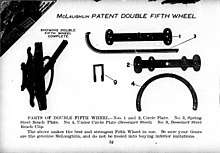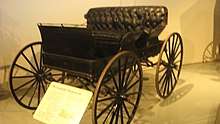McLaughlin Motor Car Company
The McLaughlin Motor Car Company Limited was a Canadian manufacturer of automobiles headquartered in Oshawa, Ontario. It became General Motors of Canada.

_(cropped).jpg)
McLaughlin


McLaughlin Carriage Company began building wheeled carriages in 1869 beside the cutters and wagons in Robert McLaughlin's blacksmith's shop in Enniskillen, a small village 20 kilometres (12 mi) northeast of Oshawa.[1] In need of more workers to build his horse-drawn carriages, staunch Presbyterian McLaughlin moved to Oshawa, Ontario in 1876.[2][3]
McLaughlin developed and in the early 1880s patented a fifth-wheel mechanism which greatly improved comfort and safety. Attracting a great deal of demand he ignored tempting offers and elected to sell the mechanism to his competitors rather than license other manufacturers. This enthusiasm, now for his complete carriages, spread across Canada and before the end of the century there was a McLaughlin sales office in London, England.[4]
In 1898 McLaughlin produced more than 25,000 carriages[1] but in 1899 the carriage works was destroyed by fire. The City of Oshawa lent McLaughlin $50,000 to rebuild.[5]
McLaughlin Carriage Company of Canada Limited was incorporated in 1901 to own the new carriage works which again produced 15,000 units, this time in 140 different models.[4]
- "An automobile of the latest design its use I will never disparage, but for comfort and pleasure give me a McLaughlin Reliable Carriage."[4]
By 1915 McLaughlin was making one carriage every ten minutes.[1] This was the year McLaughlin Carriage Company was sold to Carriage Factories Limited of Orillia, Ontario, McLaughlin's largest competitor. The major carriage manufacturers did not close their doors but switched to automobile bodies. Some of the automobiles even retained whipsockets.[4]
.jpg)
.jpg)
The McLaughlin Motor Car Company Limited was formed in 1907[6] when McLaughlin began manufacturing automobiles under the leadership of Robert's son, Colonel Sam McLaughlin.[7] McLaughlin's engine designer fell ill,[4] so, under a fifteen-year contract, the Canadian automobiles received drive trains bought-in from the Buick plant in Flint, Michigan.[8][9] These cars were sold with the brand-name McLaughlin though the name McLaughlin-Buick also appeared on some vehicles.[10] This alliance with Buick Motor Company controlled by Sam McLaughlin's friend William C. Durant was confirmed by an exchange of a large parcel of McLaughlin stock for a corresponding amount of Buick stock.[11] Durant was a partner in Durant-Dort and like Sam McLaughlin had been the largest carriage manufacturer in his country.
The following year Buick, controlled by Durant and partner McLaughlin, formed General Motors Company with Charles Stewart Mott.[12] Durant borrowed heavily and bought other automotive businesses for his General Motors including Oldsmobile, Cadillac and Oakland (Pontiac) but vehicle sales collapsed, factories were closed for twelve months and more and in 1910 Durant lost his control of General Motors Company to his bankers. Meanwhile General Motors retained the former Buick shareholding in McLaughlin.[13]
With Sam McLaughlin's financial help Durant started a new business in partnership with racing driver Louis Chevrolet. Durant took control of Chevrolet and sold stock in a new business, Chevrolet Canada, so successfully he was able to regain control of General Motors and in 1916 General Motors Corporation was formed with Sam McLaughlin Director and Vice President. McLaughlin began manufacturing Chevrolet automobiles for Durant and General Motors. By 1914 McLaughlin had built about 1,100 of his own cars.[14]
General Motors of Canada Limited
_(cropped).jpg)
.jpg)
General Motors of Canada Limited was incorporated in 1918 and bought McLaughlin and Chevrolet Canada[15][16][17]
and General Motors Corporation spent $10 million building a Walkerville, Ontario plant and establishing Canadian Products. In 1923 the name of the Canadian-bodied model was officially changed to "McLaughlin-Buick"[18] and cars with this name continued to be produced until 1942. Later production was labelled Buick without the addition of McLaughlin or Canada.[15][19]
McLaughlin remained chairman of the board of General Motors of Canada as well as vice-president and executive director of the parent company until his death, aged 100, in 1972.
Duties and other import taxes
Residents of other rapidly developing countries living under conditions not unlike US and Canada had a strong preference for well-engineered and robust American cars. The countries of the British Empire – England, India, South Africa, Australia and others – gave preference by charging much lower import taxes on goods from another member of the empire, such as Canada. Taxes were adjusted to the proportion of Canadian content. Canada made and supplied General Motors vehicles to those countries also fitting them with right-hand drive. During World War I Britain erected high tariff barriers to protect their own industry from America's low-priced mass-produced but good-quality cars. By 1923 Canada had the world's second-largest automotive industry. These exports fell to a trickle after World War II[note 1] because Canada was part of the dollar area and therefore set apart from the British Empire's sterling area. The British were struggling to repay US War Loans and unwilling to allow their businesses unrestricted access to Canada's currency to buy Canadian cars.
The automobiles

The first McLaughlin automobile was the 1908 Model F.[10]
Until 1914, the cars were finished with the same paints and varnishes used on carriages. This meant each vehicle required up to fifteen coats of paint.
In 1927 two identical specially designed four-door touring cars were built for the Royal Tour of Canada, one to be shipped ahead to the next city while the other was in use.[20]
In 1936 a McLaughlin-Buick was purchased by the Prince of Wales.[21]
In 1936 the Dunsmuirs, a coal magnate family in Victoria, British Columbia, ordered 3 special order 1936 Buick-McLaughlin Phaetons for 3 of their daughters.[22] In 1937 the Phaeton roadster bought for Elinor Dunsmuir was used to drive US president Franklin Roosevelt around Victoria, BC during his state visit. This is verified by photos appearing in the Daily Colonist and the Victoria Times newspapers Oct 1, 1937 because each of the Dunsmuir phaetons was unique. [23]
Two McLaughlin-Buick Phaetons were built for the 1939 Royal tour. One of these later carried Prince Charles and Princess Diana during their 1986 visit to Canada.[20]
.jpg)
.jpg)
the last year of the McLaughlin badge
Note
- "Helped along by this proximity, Windsor – and Southern Ontario more generally – became the Canadian extension of Detroit with the help of two policies. First, there was a 35 per cent National Policy tariff on cars entering Canada. This protectionist tax was designed to encourage Canadian production by making Canadian goods less expensive than their foreign (mostly American-sourced) competitors. Second, since Canada was part of the British Empire, Canadian-made goods could be shipped to many countries in the Empire (later, the British Commonwealth) at a lower tariff rate than other countries, namely the United States." (quoted from The Canadian Encyclopedia, Automotive Industry accessed 8 July 2017)
See also
- General Motors Canada
- List of automobile manufacturers
- Reynolds-Alberta Museum
- Canadian Automotive Museum
- 1928 McLaughlin Buick Automobile video and essay in the Virtual Museum of Canada
- McLaughlin Motor Car Showroom
References
- Historical placard at Western Development Museum.
- Henry W. Meyer (1965). Memories of the buggy days: an authentic historical outline of the carriage, wagon, sleigh, harness and accessory business in the United States of America and Canada. Brinker, distributor. p. 121.
- M. McIntyre Hood (1967). Oshawa: "The Crossing Between the Waters": A History of "Canada's Motor City". Published as a Canadian Centennial project by McLaughlin Public Library Board. p. 114.
- Oakley H Bush, The McLaughlin Carriage Company. The Carriage Journal: Vol 21 No 1 Summer 1983. The Carriage Association of America Inc, Salem, New Jersey
- "Robert Samuel McLaughlin". The Canadian Encyclopedia. Margaret E. McCallum, 06/04/2008
- Buick, The Times Friday, Jul 01, 1927; pg. vii; Issue 44622
- Paul Arculus (September 2011). Durant's Right-Hand Man. FriesenPress. pp. 109–110. ISBN 978-1-77067-782-1.
- Mike Filey (1 September 2000). Toronto Sketches 6: The Way We Were. Dundurn. pp. 173–. ISBN 978-1-4597-1303-1.
- David Farber (18 April 2013). Everybody Ought to Be Rich: The Life and Times of John J. Raskob, Capitalist. Oxford University Press. pp. 145–. ISBN 978-0-19-990851-6.
- Terry B. Dunham (1987). The Buick: A Complete History. Automobile Quarterly. pp. 394–395. ISBN 978-0-915038-64-0.
- Arthur Pound (1934). The Turning Wheel. Рипол Классик. pp. 236–. ISBN 978-5-87753-029-4.
- "History of General Motors, Company profile". General Motors. Archived from the original on September 25, 2007. Retrieved April 4, 2011.
- General Motors Company. The Times (London, England), Thursday, Nov 14, 1912; pg. 17; Issue 40056
- Mark Kearney; Randy Ray (1999). The Great Canadian Book of Lists. Dundurn. pp. 183–. ISBN 978-0-88882-213-0.
- "Eye Candy: 1918 McLaughlin Buick". Toronto Star, November 19, 2016, Donald Cruickshank, page W2.
- Joe Martin (19 September 2009). Relentless Change: A Casebook for the Study of Canadian Business History. University of Toronto Press. pp. 101–. ISBN 978-1-4426-9715-7.
- Financial Post September 23, 1933 page 9
- The World of Automobiles. 1974. p. 1302. ISBN 978-0-8393-6179-4.
- Automobile Quarterly. Automobile Quarterly. 1974. pp. 416–418.
- Peter Pigott (19 November 2005). Royal Transport: An Inside Look at The History of British Royal Travel. Dundurn. pp. 110–. ISBN 978-1-55488-285-4.
- Cars and Parts. Amos Press. 1995. p. 18.
- I'll Never Forget My First Car: Stories From Behind The Wheel. Dundurn. 2007. p. 160.
- "Dunsmuirs' luxury car ferried FDR during Victoria visit". Victoria Times Colonist. 20 June 2015.
- Heather Robertson, Driving Force, The McLaughlin Family and the Age of the Car, McClelland & Stewart Inc., 1995, ISBN 0-7710-7556-1
External links
| Wikimedia Commons has media related to McLaughlin carriages. |
| Wikimedia Commons has media related to McLaughlin automobiles. |
| Wikimedia Commons has media related to McLaughlin-Buick automobiles. |
- Ingenium Canada's Museum of Science and Technology
- McLaughlin family fonds, Archives of Ontario